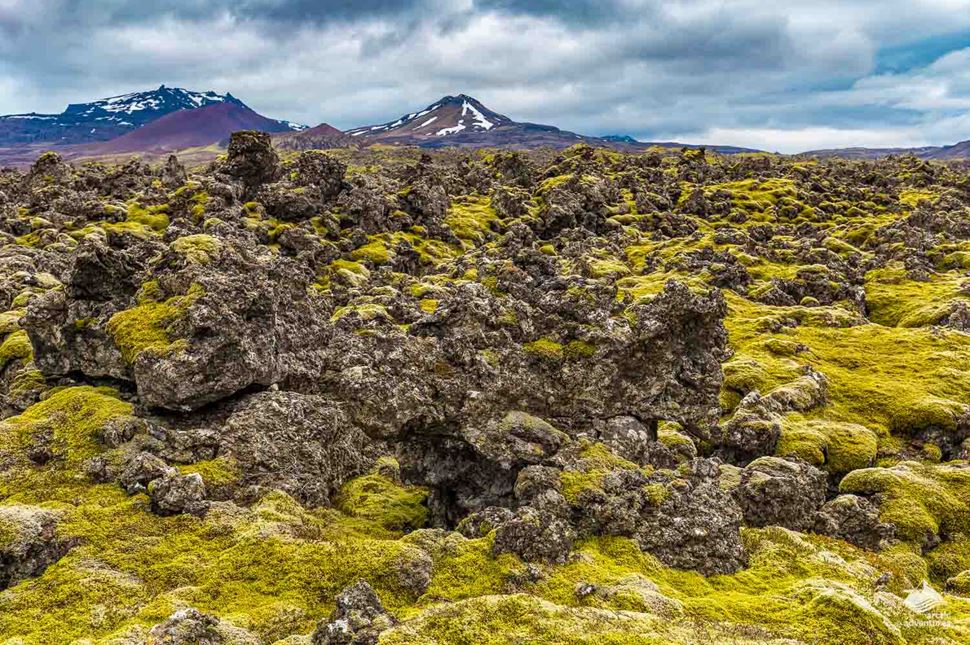Every night could be an aurora night. Don't Miss Out
Iceland’s history with volcanoes has been incredibly dramatic. Rivers of magma have flowed across the country’s surface over the centuries, forming caves, valleys and lava fields that stand to this day.
Our lava fields are especially fascinating. Just as no two volcanoes are the same, lava fields contrast wildly, varying in shape, size and even colour, depending on where they are, how they formed and when they were created.
And, as you might expect, lava fields tend to be close to other incredible sites; like ice caves, lava tunnels, bodies of water and – of course – volcanoes.


Like much of Iceland, Eldhraun is both remarkable and unique. Stretching across 565 square kilometres, it’s lumpy, mossy and otherworldly. Traversing this field means walking across uneven rocks, but the terrain’s ruggedness is softened by being blanketed entirely in soft green fuzz.
What was once barren and devastated by lava is now lush with green. Life, as a famous film once told us, finds a way.
Eldraun is a three-hour drive southeast of Reykjavik following Route 49. Or you could take one of the tours listed above.
Eldghraun is close to several fascinating and beautiful spots, including the distinctive, fascinating Diamond Beach and the frozen wonderland that is the Jokulsarlon Glacier Lagoon.

The ashen lava fields of Krafla are still bubbling and steaming – a far cry, so, from the greenery of Eldhraun.
This is the site of some 29 eruptions over the centuries, many of which shaped the landscape you see today. The area is also a source of tremendous green energy. The first geothermal plant was built here in 1977.
This site is a seven-hour drive from Rejkavik, or you can take a 45-minute flight from that city. From there, it’s a mere 90-minute drive. Or you can visit it as part of the Askja Caldera Tour mentioned above.

The Geirlandshraun lava field leads to the Fjaðrárgljúfur Canyon. This is a spectacular part of the world, with high walls of the canyons coated in greenery and leading down to the river Fjaðrá.
The valley is believed to be caused by a glacier, some 9,000 years ago.
This glorious location is especially popular with hikers. It’s in the southeast of Iceland, about a three-hour drive from Reykjavik.
You can reach Geirlandshraun and the Fjaðrárgljúfur Canyon on the 3-Day South Coast and Golden Circle Tour mentioned above. And we have plenty more information on this stunning location in our ultimate guide to Fjaðrárgljúfur.

The dramatic lava fields of the Reykjanes Peninsula lead to the beautiful Kleifarvatn geothermal lake, a popular snorkelling spot. The surrounding area is a veritable canvas of incredible colours, which tells some of the region’s rich natural history; the rocks are shades of golden browns, while rich green moss and grass cover some areas, and brown mud pools bubble and hiss with steam.
This is one of the most accessible regions listed, as the Reykjanes Peninsula is only about 40 minutes southwest of Reykjavik. Several tours visit this area, including the popular Reykjanes Peninsula and Hot Springs Tour listed above.

A highlight of the popular Snaefellsnes Peninsula, this lava field is over 3,000 years old, with craggy, spiky grey rocks caked in lovely soft moss. This lava field sits on a small dirt road, between Stykkishólmur and Grundarfjörður.
The Snæfellsness Peninsula is bursting with things to see, by the way; including the black beaches, the fishing communities, the Volcano Museum at Stykkishólmur and the Shark Museum at Bjarnahöfn.
This is also where you can see the Kirkjufell Mountain, the legendary “arrowhead mountain” made famous in Game of Thrones.
The route to Berserjahraun is a well-worn path. You can find it two hours northwest of Reykjavik on the famous Route 49.
Part of Iceland’s beauty and uniqueness comes from its constant change, as magma still moves, plants flourish and sleep; and the landscape changes with it. And much of this change can be seen on our diverse lava fields. We look forward to seeing you on one soon.
Check out also our volcano tours in Iceland.